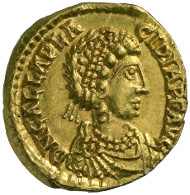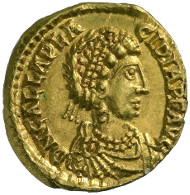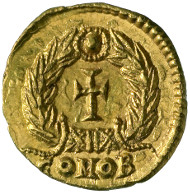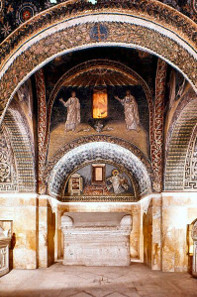Human Faces Part 20: An Ancient Power Woman
with the kind permission of the MoneyMuseum, Zurich
Why is it that for centuries – or rather thousands of years – the head has served as the motif for the side of a coin? And why has this changed in the last 200 years? Ursula Kampmann poses these questions in her book ‘MenschenGesichter,’ from which the texts for our new series are taken.
Galla Placidia was the daughter of an emperor, the sister of two emperors, the wife and mother of an emperor – plus she was a woman that, after experiencing stormy waters in her youth, made her own destiny.
Roman Imperial Times. Galla Placidia (b. around 390, d. 450). Tremissis, Rome or Ravenna, 425. Pearl-diademed, draped bust of Galla Placidia r. Rev. cross within wreath. © MoneyMuseum, Zürich.
Her father, Theodosius I, had distributed his empire to his two sons, Arcadius and Honorius. While Arcadius did pretty well in the East, the West under Honorius was being afflicted by an invasion of the Goths in 410 that cost many lives.
The most prominent victim was Galla Placidia. She was abducted and compelled to marry Gothic leader Ataulf in 414. One year later Ataulf was dead, killed.
His successor didn’t know what to do with her, so he accepted the offer of Constantius, commander-in-chief of the Western Roman Empire, to hand her over to him in exchange for 600,000 bushels of wheat. During the same year, Placidia’s brother forced her to marry her liberator because Honorius, who himself was no great military commander, wanted to tie the powerful magister militum closer to him. After a little while, he even appointed the indispensable leader co-emperor. Constantius enjoyed the new rank for the short duration of just eight months before he died.
Thus, in 421, 32 year-old Galla Placidia had become a widow for the second time and faced the prospect that her brother might marry her to the next military leader. This time, however, the woman of spirit staked out a claim on power herself, on behalf of her son. That resulted in bloody conflicts between the emperor and his sister. Galla Placidia had to flee to the Eastern Roman Empire.
The exile, however, didn’t take very long. Honorius died only one year later and Galla Placidia set to work on securing her son Valentinian the command over the West. And she succeeded. In 425, the six year-old was appointed Augustus of the West. Until his 18th birthday, however, his mother reigned. Gallia Placidia stopped to act as regent as late as 437.
The interior of the Mausoleum of Galla Placidia in Ravenna. Photograph: Wikicommons / http://creativecommons.org/licenses/by-sa/3.0/deed.en
She must have been a tough woman, that Galla Placidia, because not even when she realized that her son wasn’t up to his job and others gained more and more influence on him did she try to force herself or her opinion onto him.
Galla Placidia died 13 years after she had withdrawn from power on 27 November 450. And that was a good thing since it spared her from witnessing her son being assassinated in revenge.
The next episode looks at Justinian who was the first to have Christ depicted on coins although he didn’t win unequivocal praise for doing so.
All sections of the series can be found here.
The book ‘MenschenGesichter’ is available in printed form from the Conzett Verlag website. It soon will be translated to English …










